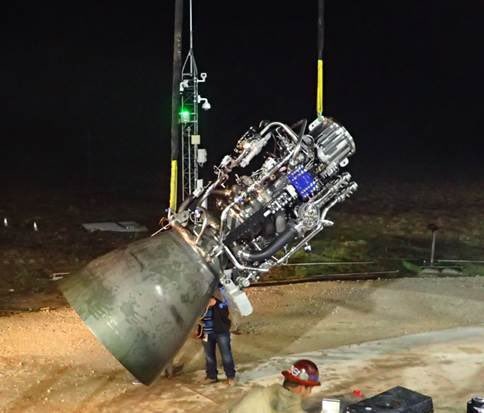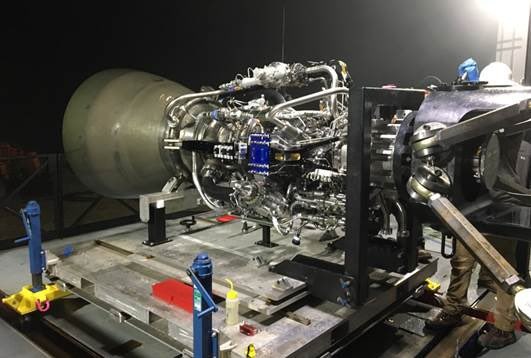| 發表文章 | 發起投票 | 回覆 |
【科技台】SpaceX全尺寸大推力火箭引擎「猛禽」已運抵德州測試場
外電報導:
https://www.teslarati.com/spacex-ceo-elon-musk-official-photos-starship-completed-starship-raptor-engine/


Eric Ralph
ByEric RalphPosted on January 31, 2019
Shortly after Teslarati reported that the first operationalized Raptor had shipped to McGregor, Texas for its first full-scale static fire tests, SpaceX CEO Elon Musk took to Twitter to post the first official photos of the “radically redesigned” engine preparing for its critical debut test fire in Texas.
Designed with extreme reliability, efficiency, and reusability in mind, the Raptor seen in Musk’s photos is rated for just shy of 2.5 times the thrust of Merlin 1D at 200 tons (450,000 lbf) and has been commonized across both stages of BFR (Starship and Super Heavy) to spread out development costs and speed up the next-generation rocket’s orbital launch debut.
Aside from revealing some impressive photos of the first upgraded Raptor preparing for a static fire test, Musk went into a bit more detail on the future of the engine and its probable development path, describing Raptor in its current iteration as a sort of compromise between achieving nominal performance and minimizing the cost and timescale to arrive at a flight-ready engine. Currently stationed at SpaceX’s McGregor, Texas development and testing facilities, Raptor appears to feature an expansion ratio somewhere in between Merlin 1D (optimized for sea-level) and MVac (optimized for vacuum).
This increases the stress on the nozzle during ignition and operation at normal atmospheric pressures but it also improves engine efficiency once Starship (or Super Heavy) rises above the thickest parts of Earth’s atmosphere, even if a medium-expansion nozzle still can’t touch the performance of a giant vacuum-optimized bell like those used by MVac. As such, BFR in its earliest iterations will be significantly less capable than a fully-optimized version of the rocket when it comes to high-energy Earth/lunar orbits and interplanetary trajectories, a challenge that can at least initially be hurdled by accepting much lower nominal payload capabilities and relying on brute-force performance, much like Falcon 9 and Heavy.
==========================
200噸推力(最終將升級至250噸),真空比沖380s,全流量分級燃燒循環,SpaceX火星太空船既動力來源
https://www.teslarati.com/spacex-ceo-elon-musk-official-photos-starship-completed-starship-raptor-engine/


Eric Ralph
ByEric RalphPosted on January 31, 2019
Shortly after Teslarati reported that the first operationalized Raptor had shipped to McGregor, Texas for its first full-scale static fire tests, SpaceX CEO Elon Musk took to Twitter to post the first official photos of the “radically redesigned” engine preparing for its critical debut test fire in Texas.
Designed with extreme reliability, efficiency, and reusability in mind, the Raptor seen in Musk’s photos is rated for just shy of 2.5 times the thrust of Merlin 1D at 200 tons (450,000 lbf) and has been commonized across both stages of BFR (Starship and Super Heavy) to spread out development costs and speed up the next-generation rocket’s orbital launch debut.
Aside from revealing some impressive photos of the first upgraded Raptor preparing for a static fire test, Musk went into a bit more detail on the future of the engine and its probable development path, describing Raptor in its current iteration as a sort of compromise between achieving nominal performance and minimizing the cost and timescale to arrive at a flight-ready engine. Currently stationed at SpaceX’s McGregor, Texas development and testing facilities, Raptor appears to feature an expansion ratio somewhere in between Merlin 1D (optimized for sea-level) and MVac (optimized for vacuum).
This increases the stress on the nozzle during ignition and operation at normal atmospheric pressures but it also improves engine efficiency once Starship (or Super Heavy) rises above the thickest parts of Earth’s atmosphere, even if a medium-expansion nozzle still can’t touch the performance of a giant vacuum-optimized bell like those used by MVac. As such, BFR in its earliest iterations will be significantly less capable than a fully-optimized version of the rocket when it comes to high-energy Earth/lunar orbits and interplanetary trajectories, a challenge that can at least initially be hurdled by accepting much lower nominal payload capabilities and relying on brute-force performance, much like Falcon 9 and Heavy.
==========================
200噸推力(最終將升級至250噸),真空比沖380s,全流量分級燃燒循環,SpaceX火星太空船既動力來源
本貼文共有 1 個回覆
裝喺架戰機度會人散先定機散先?

| 發表文章 | 發起投票 | 回覆 |

